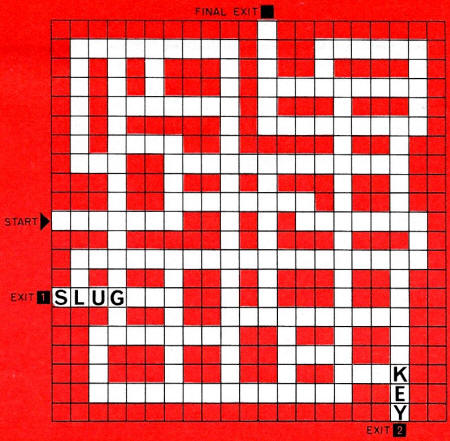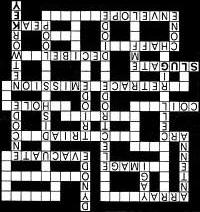|
February 1966 Popular Electronics
 Table of Contents
Table of Contents
Wax nostalgic about and learn from the history of early electronics. See articles
from
Popular Electronics,
published October 1954 - April 1985. All copyrights are hereby acknowledged.
|
Robert Radford's (not to be confused
with Robert Redford) "Electromaze" is a unique - and weird - sort of word puzzle that
first appeared in this February 1966 issue of Popular Electronics magazine. Some
people have been confused about the strategy, believing that all the white spaces needed to
be filled in. They do not. Just because a letter might have an empty square adjacent
to it does not imply that another letter must fill it. Also, read the instruction
carefully, especially the part about the last letter of one word being the first
letter of another word. You will probably want to print
out the maze grid and find an old guy who should still have a pencil stowed away somewhere
you can borrow to use for filling in the boxes.Here are the
February 1966,
April 1966, and
June 1966 Electromaze Puzzles.
Electromaze Puzzle
 By Robert C. Radford By Robert C. Radford
Here's a new kind of crossword puzzle designed to test your knowledge of electronic
terminology. Refer to the clues given and fill in the word called for by the first clue.
Start at the arrow. Thereafter, fill in each new word called for by the following clues
perpendicular to each preceding word. The last letter in each preceding word will be
common to the first or lost letter of each new word, and all words will read vertically
downward or from left to right. The tenth word will have a letter in common with the
word at the first exit. Nine more correct entries will take you to the word at the second
exit, which will also share a letter with the last of these nine words. In each case,
the first or last letter of the exit word will be the first or last letter of the next
word. An additional nine correct entries will put you at the final exit for a perfect
score. The Editors invite your comments on this type of puzzle.
 Clues: Clues:
1 A component that introduces inductance in on a.c. circuit.
2 Single unit of a device that converts chemical energy into electrical energy.
3 A luminous glow formed by the difference of potential between two electrodes.
4 Conductors used for transmitting and receiving r. f. energy.
5 Antennas specifically arranged or grouped together so as to produce a desired directivity
pattern.
6 High-gain VHF antenna array whose directors are made progressively shorter toward
the front of the array.
7 The video information reproduced by a television receiver.
8 Conductor used to establish electrical contact with a non-metallic part of a circuit.
9 Lines produced by a TV receiver flyback pulse.
10 Slang term for ham radio equipment.
Exit 1. The adjustable iron core of a coil.
11 A circuit operating as a switch. The presence or absence of a control voltage can
apply or eliminate a signal.
12 Abbreviation for the force that causes current to flow in a circuit.
13 Narrow metallic strips used to produce clutter on enemy radar screen to obscure
targets.
14 A The paper diaphragm of a loudspeaker.
15 Waveform of a modulated carrier.
16 Two-element electron tube.
17 The unit used to express power ratio.
18 Path of a completed circuit, especially in servo systems.
19 Maximum amplitude of a sine wave.
Exit 2. A hand-operated switch used in radio telegraphy.
20 System of interconnected electrical circuits.
21 Flow of electrons in a vacuum tube.
22 A three-element electron tube.
23 Group of three phosphor dots on a color television picture tube.
24 Slang word for a parabolic reflector.
25 In solid-state technology, empty space in the valence bond of on impurity atom.
26 Preparation of a computer routine in machine language.
27 To remove gases from on electron tube envelope.
28 A secondary emission electrode in a multiplier-type photo-tube.
See answer below.
Here are other electronics-themed crossword puzzles from vintage electronics
magazines (RF Cafe
Crosswords here):
 Electromaze Solution Electromaze Solution
1 Coil
2 Cell
3 Arc
4 Antenna
5 Array
6 Yagi
7 Image
8 Electrode
9 Retrace
10 Rig
Exit 1. Slug
11 Gate
12 EMF
13 Chaff
14 Cone
15 Envelope
16 Diode
17 Decibel
18 Loop
19 Peak
Exit 2. Key
20 Network
21 Emission
22 Triode
23 Triad
24 Dish
25 Hole
26 Encode
27 Evacuate
28 Dynode
Posted October 26, 2018
|



























 By Robert C. Radford
By Robert C. Radford 

